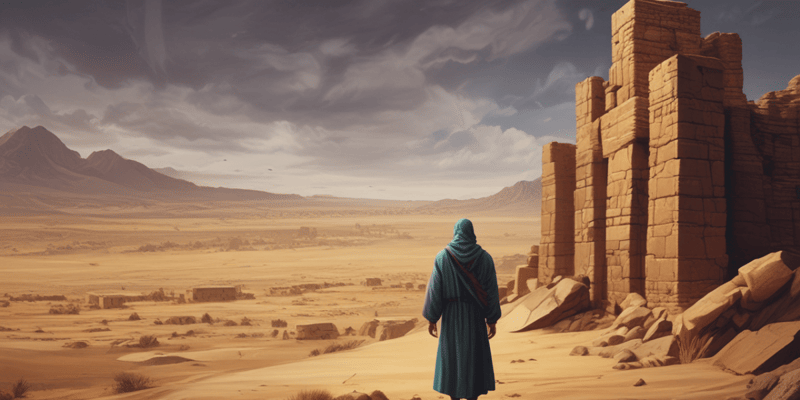56 Questions
Ezra and Nehemiah form one book in the Hebrew Bible because they tell two separate stories.
False
The Babylonian Captivity began in 587 b.c.
False
Jeremiah had predicted a hundred-year period of captivity.
False
Ezra was a priest and a king.
False
Ezra was a man of prayer and was greatly burdened for the spiritual welfare of his people.
True
Babylon falls to Cyrus and the Media-Persian empire begins in 586 b.c.
False
Ezra travels to Jerusalem in 535 b.c.
False
The temple is completed and dedicated in 520 b.c.
False
Ezra led the first group of Jews back to Jerusalem.
False
Zerubbabel was a prophet.
False
Nehemiah was a priest.
False
The captivity of the Jews cured them of idolatry.
True
Cyrus's decree was in 539 B.C.
False
Sheshbazzar is another name for Nehemiah.
False
About 10,000 Jews returned to Jerusalem.
False
The word 'tirshatha' means 'prophet'.
False
The NT makes it clear that only ten tribes were represented in the remnant.
False
Jesus will one day judge ten tribes.
False
Haggai's four messages include the rebuke of the people for building their own houses and neglecting God's house.
True
The Jews had no desire to return to their Promised Land after settling down in Babylon.
True
The Book of Zechariah deals with a different period of time than the Book of Haggai.
False
Tatnai the governor was not within his rights to ask about the building program.
False
The altar was not the center of Jewish worship.
False
Elijah set up the altar again in 1 Kings 18:30ff.
True
Sheshbazzar is not Zerubbabel.
False
Nehemiah was not a willing person to do God's work.
False
The people established the sacrifices and kept the feasts in the seventh month.
True
The people started the work of rebuilding the temple in the second month (our April-May).
True
Nehemiah held a low position in the court.
False
Nehemiah did not care about the news of Jerusalem.
False
The Levites did not assist the workers on the job.
False
Nehemiah prayed for only a day when he heard the news of Jerusalem.
False
The people of the land offered to assist the Jews in their work, and Zerubbabel and Joshua accepted their aid.
False
The people of the land built their own temple on Mt. Gerazim.
True
Nehemiah did not confess his sins and the sins of his people in his prayer.
False
Nehemiah did not ask God for servants to help him in the task.
False
The work on the temple ceased for nearly fifteen years (534-520).
True
The prophets Haggai and Zechariah did not proclaim the Word of God, prompting the resumption of the work on the temple.
False
The valley gate is the first gate mentioned in Nehemiah.
True
The dung gate is used to take in the waste and refuse of the city.
False
The gate of the fountain illustrates the ministry of Jesus Christ.
False
The water gate speaks of the Word of God, which cleanses the believer.
True
The horse gate is mentioned in verse 25.
False
The east gate is associated with the second coming of Jesus Christ.
True
The gate Miphkad speaks of God's mercy.
False
The Christian will face judgment because of their sins.
False
Nehemiah was a man of sorrows.
True
The king would not allow anyone to appear before him with sadness or bad news.
True
Nehemiah told the king all his heart before praying to God.
False
Nehemiah arrived at the city as a servant, not a governor.
False
Nehemiah believed in a one-man ministry.
False
The spiritual leaders took the lead in the work of repairing the walls.
True
All the nobles of Judah cooperated with Nehemiah in repairing the walls.
False
The sheep gate was the last gate repaired.
False
The valley gate reminds us of the glories of heaven.
False
Nehemiah saw less of the situation at night than others could see in the light.
False
Study Notes
Introduction to Ezra and Nehemiah
- The books of Ezra and Nehemiah form one book in the Hebrew Bible, telling the story of the return of the remnant to Jerusalem and the rebuilding of the city and the temple.
- The Babylonian Captivity began in 606 B.C. and lasted for 70 years, as predicted by Jeremiah (Jer. 25:12-14; 29:10-14).
- The period of captivity is marked by the deportation of Jews, including Daniel and Ezekiel, and the eventual return of the remnant to Jerusalem.
Chronology of the Period
- 606-605 B.C.: Babylon begins invading and deporting Jews.
- 587 B.C.: Jerusalem falls to the enemy.
- 539 B.C.: Babylon falls to Cyrus and the Media-Persian empire begins.
- 538 B.C.: Cyrus permits the Jews to return to Jerusalem.
- 535 B.C.: The Jews begin to rebuild the temple, but the work stops.
- 520 B.C.: The work begins again, and the temple is completed and dedicated in 515 B.C.
- 476 B.C.: Esther becomes Queen of Persia.
- 458 B.C.: Ezra travels to Jerusalem.
The Leaders
- Ezra:
- A godly and patriotic Jew.
- A priest and a scribe.
- Devoted student of the Scriptures.
- Helped to restore the Law to the nation.
- A man of prayer.
- Led a second group of Jews back to Jerusalem.
- Nehemiah:
- An officer in the king's court.
- A layman with no prophetic call or priestly lineage.
- Promoted to governor.
- Zerubbabel:
- A leader under Ezra.
- Also called Sheshbazzar.
- Official title was "tirshatha", meaning "governor".
- Part of the royal line of David.
- Served as the political leader of the restored nation.
- Joshua:
- The high priest at the time.
- Mentioned in Ezra 3:2, Haggai 1:1, 12, 14, and Zechariah 3:1-10.
The Lessons
- God fulfilled His promise of captivity, but also promised that a remnant would return.
- The captivity cured the Jews of idolatry and gave them a desire to know and obey the Word.
- The Jews forgot their lessons quickly, and the book of Ezra and Nehemiah serves as a reminder of God's faithfulness.
Ezra 1-5
- The return to the land (Ezra 1-2):
- Cyrus's decree to return and rebuild the temple.
- The precious things, including the temple treasures, were restored to the Jews.
- The people, including priests, Levites, and other groups, returned to Jerusalem.
- Rebuilding the temple (Ezra 3):
- Establishing the altar.
- Laying the foundation of the temple.
- The people rejoiced and sang, but older people wept, remembering the former temple.
- Resisting the enemy (Ezra 4):
- The people of the land, including Samaritans, opposed the Jews' work.
- Zerubbabel and Joshua refused their aid.
- The work ceased for 15 years due to opposition.
- Resuming the work (Ezra 5):
- The Word of God was proclaimed by Haggai and Zechariah.
- The work began again, and the temple was completed and dedicated.
Nehemiah 1-3
- Nehemiah prays for the work (Nehemiah 1):
- The report of Jerusalem's state.
- Nehemiah's response, including fasting and praying.
- His request for God's favor and protection.
- Nehemiah prepares for the work (Nehemiah 2):
- Approaching the king.
- The king's favor and provision for the work.
- Nehemiah's investigation of the city's state.
- Nehemiah prospers in the work (Nehemiah 3):
- The pattern of organization and cooperation.
- The people, including spiritual leaders, rulers, and women, worked together.
- The gates of Jerusalem, including the sheep gate, fish gate, old gate, and others, were repaired.
Explore the biblical significance of the Valley Gate and the Dung Gate in Nehemiah Chapter 3, and their relation to spiritual cleansing and renewal.
Make Your Own Quizzes and Flashcards
Convert your notes into interactive study material.
Get started for free


